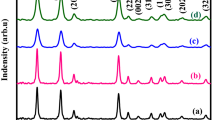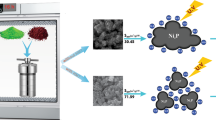Abstract
The development of materials with high active surface area/surface modification is of great interest in electrochemistry due to their widespread applications. The soft template method has become one of the prominent strategies in obtaining high surface area 3-dimensional electrodes. Herein, we explore the role of various surfactants as soft templates in achieving high surface area copper nanostructures with different morphologies and their influence on catalytic activity towards nitrate reduction reaction. Using sodium dodecyl sulphate as a soft template for copper electrodeposition to prepare dendritic copper nanostructures, and 1 M KOH as electrolyte for nitrate reduction, a maximum catalytic current density of 20 mA/cm\(^{2}\) with a low Tafel slope of 16±2 mV/dec was observed. This simple methodology is highly promising for the nitrate reduction reaction and alleviates the environmental contamination of nitrate to obtain high quality water for domestic usage.
Graphical abstract






Similar content being viewed by others

References
Shukla S, Abhishek S (2019) In handbook of environmental materials management. Springer, Netherlands. https://doi.org/10.1007/978-3-319-73645-720
Flores M, Fidel T (2021) Chemistry, safety, and regulatory considerations in the use of nitrite and nitrate from natural origin in meat products - Invited review. Meat Sci 171:108272. https://doi.org/10.1016/j.meatsci.2020.108272
Mourdi M, Pirsaheb M, Khosravi T (2016) Comparing operational cost and performance evaluation of electrodialysis and reverse osmosis systems in nitrate removal from drinking water in Golshahr, Mashhad. Desalination Water Treat 57:5391–5397. https://doi.org/10.1080/19443994.2015.1004592
Chelsey SS, Hang D, Sengupta AK (2019) Treated municipal wastewater reuse: a holistic approach using hybrid ion exchange (HIX) with concurrent nutrient recovery and CO\(_{2}\) sequestration. ACS Sustainable Chem Eng 10:9671–9679. https://doi.org/10.1021/acssuschemeng.9b01357
Fadila DB, Ouiza K, Salaheddine A (2018) Electrodialysis for fluoride and nitrate removal from synthesized photovoltaic industry wastewater. Sep Purif Technol 204:108–115. https://doi.org/10.1016/j.seppur.2018.04.068
Jianlong W, Libing C (2016) Biological nitrate removal from water and wastewater by solid-phase denitrification process. Biotechnol Adv 34:1103–1112. https://doi.org/10.1016/j.biotechadv.2016.07.001
Tingting Z, Haoyi C, Hongcheng W, Aijie W (2019) Coupled sulfur and iron(II) carbonate-driven autotrophic denitrification for significantly enhanced nitrate removal. Environ Sci Technol 53:1545–1554. https://doi.org/10.1021/acs.est.8b06865
Zhang Z, Jinsuo L (2020) Insight into the size effect of Pd nanoparticles on the catalytic reduction of nitrite in water over Pd/C catalysts. Environ Sci Nano 7:2117–2129. https://doi.org/10.1039/D0EN00417K
Joshua MM, Sarah JB, Nielander AC (2020) Electrolyte engineering for efficient electrochemical nitrate reduction to ammonia on a titanium electrode. ACS Sustainable Chem Eng 8:2672–2681. https://doi.org/10.1021/acssuschemeng.9b05983
Wang Z, Danielle R, Nirala S (2021) Recent discoveries in the reaction mechanism of heterogeneous electrocatalytic nitrate reduction. Catal Sci Technol 11:705–725. https://doi.org/10.1039/D0CY02025G
Huang W, Zhang B, Zhenya Z, Chuanping F (2013) An electrochemical process intensified by bipolar iron particles for nitrate removal from synthetic groundwater. J Solid State Electrochem 17:1013–1020. https://doi.org/10.1007/s10008-012-1956-4
Christopher AF, Michael J, Marcel MM (2007) New processes and players in the nitrogen cycle: the microbial ecology of anaerobic and archaeal ammonia oxidation. ISME J 1:19–27. https://doi.org/10.1039/D0CY02025G
Thomson AJ, Giannopoulos G, Baggs EM (2012) Biological sources and sinks of nitrous oxide and strategies to mitigate emissions. ISME J 367:1157–1168. https://doi.org/10.1098/rstb.2011.0415
Chen GF, Haifeng J, Haihui W (2020) Electrochemical reduction of nitrate to ammonia via direct eight-electron transfer using a copper-molecular solid catalyst. Nat Energy 5:605–613. https://doi.org/10.1038/s41560-020-0654-1
Shiha YY, Lina CY (2020) Manipulating the crystalline morphology and facet orientation of copper and copper-palladium nanocatalysts supported on stainless steel mesh with the aid of cationic surfactant to improve the electrochemical reduction of nitrate and N\(_{2}\) selectivity. Appl Catal B Environ 273:119053. https://doi.org/10.1016/j.apcatb.2020.119053
Zhang X, Yuting W, Bin Z (2021) Recent advances in non-noble metal electrocatalysts for nitrate reduction. Chem Eng J 403:126269. https://doi.org/10.1016/j.cej.2020.126269
Huang CP, Huang YH, Shih YJ (2020) Electrochemical nitrate reduction as affected by the crystal morphology and facet of copper nanoparticles supported on nickel foam electrodes (Cu/Ni). Chem Eng J 383:123157. https://doi.org/10.1016/j.cej.2019.123157
Hossain M, Toshikazu K, Katsuaki S, Nakata K (2020) Reduction of nitrate on tin-modified palladium-platinum electrodes. J Electroanal Chem 864:114041. https://doi.org/10.1016/j.jelechem.2020.114041
Yuting W, Zhou W, Ranran J, Zhang B (2020) Unveiling the activity origin of copper-based electrocatalyst for selective nitrate reduction to ammonia. Angew Chem Int Ed 59:5350–5354. https://doi.org/10.1002/anie.201915992
Getting T, Ivan Z (2012) A review of nitrate reduction using inorganic materials. Environ Technol Rev 1:46–58. https://doi.org/10.1080/09593330.2012.706646
Mwale S, Munyati MO, Nyirenda J (2021) Preparation, characterization, and optimization of a porous polyaniline-copper anode microbial fuel cell. J Solid State Electrochem 25:639–650. https://doi.org/10.1007/s10008-020-04839-0
Naveen B, Kumar PS (2020) Templated bimetallic copper-silver nanostructures on pencil graphite for amperometric detection of nitrate for aquatic monitoring. J Electroanal Chem 856:113660. https://doi.org/10.1016/j.jelechem.2019.113660
Rajendra GRK, Kumar PS (2017) Template electrodeposition of high-performance copper oxide nanosensors for electrochemical analysis of hydrogen peroxide. Mater Sci Eng C 75:1480–1488. https://doi.org/10.1016/j.msec.2017.02.125
Wang N, Zhang L, Zhang YW (2011) Role of surfactants in construction of porous copper film by electrodeposition approach. Trans Inst Met Finish 89:261–267. https://doi.org/10.1179/174591911X13119320025636
Meakin P (1998) Fractals, scaling and growth far from equilibrium. Cambridge University Press, Cambridge. https://doi.org/10.1002/(SICI)1099-1204(199911/12)12:6<493::AID-JNM346>3.0.CO;2-7
Swastika B, Srijan S, Manila M (2017) Substrate effect on electrodeposited copper morphology and crystal shapes. Surf Eng 34:485–492. https://doi.org/10.1080/02670844.2017.1321265
Yasin G, Muhammad A, Muhammad N, Shakeel M (2018) Effect of surfactant concentration in electrolyte on the fabrication and properties of nickel-graphene nanocomposite coating synthesized by electrochemical co-deposition. RSC Adv 8:20039–20047. https://doi.org/10.1039/C7RA13651J
Romano D, Marco C, Lorusso L, Giulia B (2020) Surfactant self-assembling and critical micelle concentration: One approach fits all. Langmuir 36:5745–5753. https://doi.org/10.1021/acs.langmuir.0c00420
Kang CC, Heng KT, Jane S (2019) Strong competition between adsorption and aggregation of surfactant in nanoscale systems. J Colloid Interface Sci 553:674–681. https://doi.org/10.1016/j.jcis.2019.06.075
Ying Y, Juan U, Xiaohui N (2014) Controllable morphology and conductivity of electrodeposited Cu\(_{2}\)O thin film: effect of surfactants. ACS Appl Mater Interfaces 6:22534–22543. https://doi.org/10.1021/am506657v
Lopez CM, Kyoung SC (2006) Electrochemical synthesis of dendritic zinc films composed of systematically varying motif crystals. Langmuir 22:10625–10629. https://doi.org/10.1021/la0611864
Colleen M, Kyoung SC (2009) Photocurrent enhancement of n-type Cu\(_{2}\)O electrodes achieved by controlling dendritic branching growth. J Am Chem Soc 131:2561–2569. https://doi.org/10.1021/ja806370s
Kanga J, Chan MK, Sung KC (2019) Octylphenol ethoxylate surfactant as a suppressor in copper electrodeposition. Trans Inst Met Finish 97:22–27. https://doi.org/10.1080/00202967.2019.1551276
Christina WL, Matthew MK (2012) CO\(_{2}\) reduction at low overpotential on Cu electrodes resulting from the reduction of thick Cu\(_{2}\)O Films. J Am Chem Soc 134:7231–7234. https://doi.org/10.1021/ja3010978
Ureta Z, Yanez C, Reyes G (1998) Electrodeposited Pt-Ir electrodes: characterization and electrocatalytic activity for the reduction of the nitrate ion. J Solid State Electrochem 2:191–197. https://doi.org/10.1007/s100080050086
Alexandria RC, Amanda LC, Andricus LB (2020) Electrochemical impedance spectroscopy of metal oxide electrodes for energy applications. ACS Appl Energy Mater 3:66–98. https://doi.org/10.1021/acsaem.9b01965
Krishnamoorthy K, Veerasubramani G, Pazhamalai P (2016) Designing two dimensional nanoarchitectured MoS\(_{2}\) sheets grown on Mo foil as a binder free electrode for supercapacitors. Electrochim Acta 190:305–312. https://doi.org/10.1016/j.electacta.2015.12.148
Han GQ, Liu YR, Dong B, Hu WH (2016) Crystallographic structure and morphology transformation of MnO\(_{2}\) nanorods as efficient electrocatalysts for oxygen evolution reaction. J Electrochem Soc 163:H67–H73. https://doi.org/10.1149/2.0371602jes
Mei BA, Jonathan L, Terri T, Sarah H (2018) Physical interpretations of electrochemical impedance spectroscopy of redox active electrodes for electrical energy storage. J Phys Chem C 122:24499–24511. https://doi.org/10.1021/acs.jpcc.8b05241
Ibris N, Rosca M, Santana A (2002) Comparitive EIS study of a paste electrode containing zinc powder in neutral and near neutral solutions. J Solid State Electrochem 6:119–125. https://doi.org/10.1007/s100080000192
Naveen B, Purusottam B, Kumar PS (2021) Dual performing copper-platinum core-shell nanozyme for environmental electrochemistry-electrocatalytic oxidation and electroanalysis of ammonia. Environ Sci Nano 8:3603–3612. https://doi.org/10.1039/D1EN00739D
Ershuai L, Jingkun L, Qingying J (2020) Interfacial water shuffling the intermediates of hydrogen oxidation and evolution reactions in aqueous media. Energy Environ Sci 13:3064–3074. https://doi.org/10.1039/D0EE01754
Mattarozzi L, Cattarin S, Comisso N, Gambirasi A (2014) Hydrogen evolution assisted electrodeposition of porous Cu-Ni alloy electrodes and their use for nitrate reduction in alkali. Electrochim Acta 140:337–344. https://doi.org/10.1016/j.electacta.2014.04.048
Yachao Z, Cameron P, Guofeng M (2020) Restoring the nitrogen cycle by electrochemical reduction of nitrate: progress and prospects. Small Methods 4:2000672. https://doi.org/10.1002/smtd.202000672
Sang EB, Steart KL, Andrew A (2007) Nitrate adsorption and reduction on Cu(100) in acidic solution. J Am Chem Soc 129:10171–10180. https://doi.org/10.1021/ja071330n
David R, Daniel B, Lionel R (2008) Study of the electroreduction of nitrate on copper in alkaline solution. Electrochim Acta 53:5977–5984. https://doi.org/10.1016/j.electacta.2008.03.048
Tonghe Z, Qiongshan C, Chunhua F (2020) Single-atom Cu catalysts for enhanced electrocatalytic nitrate reduction with significant alleviation of nitrite production. Small 15:2004526. https://doi.org/10.1002/smll.202004526
Jing W, Jianping Y, Weixian Z, Hui X (2020) Dendritic cell-inspired designed architectures toward highly efficient electrocatalysts for nitrate reduction reaction. Small 16:2001775. https://doi.org/10.1002/smll.202001775
Guoshen Z, Chihhsiang W, Mengqi Z, Xiaodan W (2020) Three-dimensional Cu nanobelt cathode for highly efficient electrocatalytic nitrate reduction. Nanoscale 12:9385–9391. https://doi.org/10.1039/C9NR10743F
Yuhang W, Ziyun W, Linsong H, Aoni X (2020) Enhanced nitrate-to-ammonia activity on copper-nickel alloys via tuning of intermediate adsorption. J Am Chem Soc 142:5702–5708. https://doi.org/10.1021/jacs.9b13347
Yimei Y, Yalong Z, Zhuang C, Liqun W (2018) Fe/Cu composite electrode prepared by electrodeposition and it’s excellent behavior in nitrate electrochemical removal. J Electrochem Soc 165:E420–E428. https://doi.org/10.1149/2.0081810jes
Lele W, Miao L, Chuanping F, Xiang L (2017) Electrochemical behavior of Ti-based nano-electrode for highly efficient denitrification in synthetic groundwater. J Electrochem Soc 164:E326–E331. https://doi.org/10.1149/2.0821712jes
Jianan G, Congcong N, Jiang B, Yanqing Z (2019) Non-precious Co\(_{3}\)O\(_{4}\)-TiO\(_{2}\)/Ti cathode based electrocatalytic nitrate reduction: preparation, performance and mechanism. Appl Catal B Environ 284:394–402. https://doi.org/10.1016/j.apcatb.2019.05.016
Gallent EP, Figueiredo MC, Katsounaros I, Koper MTM (2017) Electrocatalytic reduction of Nitrate on Copper single crystals in acidic and alkaline solutions. Electrochim Acta 227:77–84. https://doi.org/10.1016/j.electacta.2016.12.147
Masaru K, Taguchi S, Okui M, Yagi I (2017) Electrocatalytic nitrate reduction on well-defined surfaces of tin-modified platinum, palladium and platinum-palladium single crystalline electrodes in acidic and neutral media. J Electroanal Chem 800:46–85. https://doi.org/10.1016/j.jelechem.2017.01.020
Katsounaros I, Figueiredo MC (2018) Interconversions of nitrogen-containing species on Pt(100) and Pt(111) electrodes in acidic solutions containing nitrate. Electrochim. Acta 271:77–83. https://doi.org/10.1016/j.electacta.2018.03.126
Karamad M, Cullen DA, Huang Q, Wong MS (2021) Electrochemical ammonia synthesis via nitrate reduction on Fe single atom catalyst. Nat Comm 12:2870. https://doi.org/10.1038/s41467-021-23115-x
Acknowledgements
BN thanks SASTRA Deemed University for financial assistance through Teaching Assistant.
Funding
PSK received financial support from Department of Science and Technology, Govt. of India through Young Scientist Initiative programme (SB/FT/CS-148/2013) and Water Technology Initiative program (WTI/2K16/215).
Author information
Authors and Affiliations
Corresponding author
Ethics declarations
Conflict of interest
The authors declare no competing interests.
Additional information
Publisher’s Note
Springer Nature remains neutral with regard to jurisdictional claims in published maps and institutional affiliations.
Rights and permissions
Springer Nature or its licensor holds exclusive rights to this article under a publishing agreement with the author(s) or other rightsholder(s); author self-archiving of the accepted manuscript version of this article is solely governed by the terms of such publishing agreement and applicable law.
About this article
Cite this article
Bommireddy, N., Palathedath, S.K. Surfactant mediated electrodeposition of copper nanostructures for environmental electrochemistry: influence of morphology on electrochemical nitrate reduction reaction. J Solid State Electrochem 26, 2733–2742 (2022). https://doi.org/10.1007/s10008-022-05279-8
Received:
Revised:
Accepted:
Published:
Issue Date:
DOI: https://doi.org/10.1007/s10008-022-05279-8



